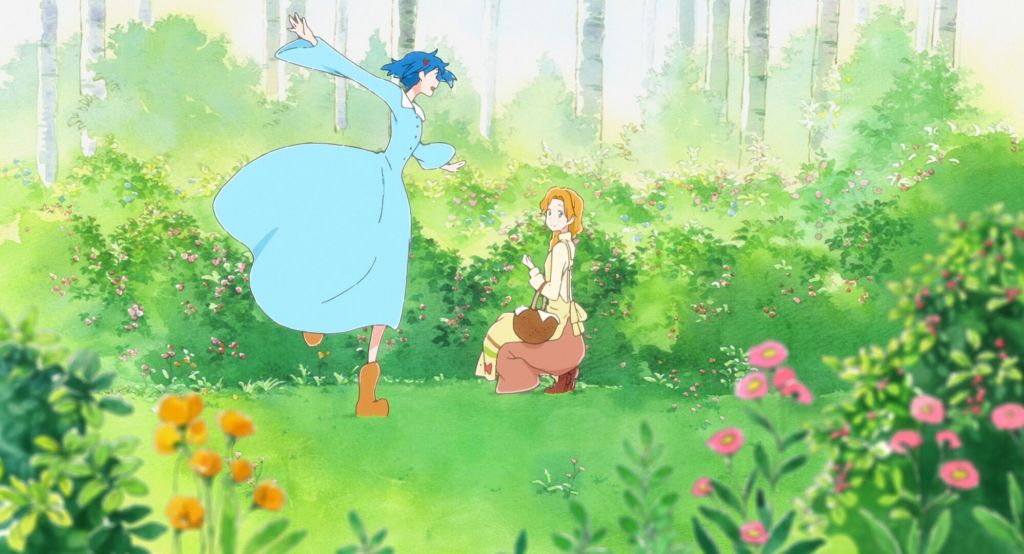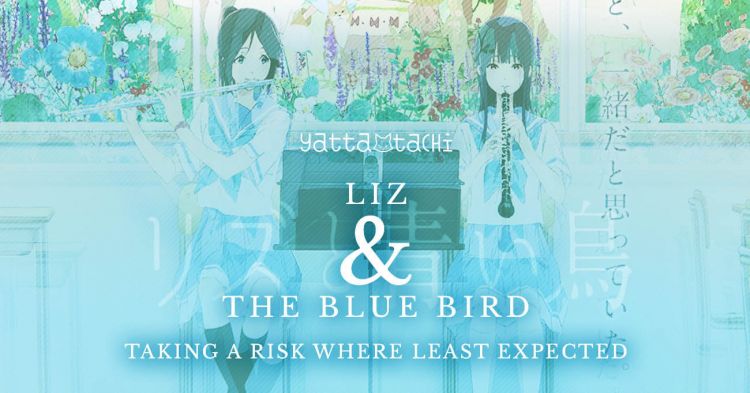Don’t let the title mislead you on this one, Liz and the Blue Bird (Liz to Aoi Tori) is a side story of the Sound! Euphorium (Hibiki! Euphorium) television anime series. Despite that, the film features two side characters from the show rather than the whole cast and while previous knowledge of the series isn’t really required, I feel that it could help a bit. As someone who hasn’t watched the anime series, it made me wonder how I would enjoy the film.
Let’s Go!
The Story
The story of Liz and the Blue Bird mainly deals with the simple, yet close, relationship between two side characters from the main series: Mizore Yoroizuka and Nozomi Kasaki. The title of the movie has to deal with a folklore tale that’s used to describe the piece of music that the two of them play. The story itself is very simplistic and straightforward; however, I feel that this film is a great example that you don’t need a lot of complexity to tell a really good story. When a story just focuses on the two characters without any worry of complexity, it allows itself to set a pacing that makes everything flow naturally. While some may feel that the film leaps from time point to time point rather quickly, it does so in a way that gives you the information you need about the story while discarding anything that would be deemed as unnecessary.
The majority of the film takes place on the school’s campus as well as the school’s music room. This was done on purpose to put as much attention and focus on the characters and their story as possible. This leaves the rest of the outside world up to the viewer’s imagination, which is actually a wise decision. If this film’s purpose was to focus on these two characters, then confining them as they have was the best solution. This allows the viewing audience to see these characters at the forefront rather than exploring the world around them. If you were to explore the world, then the need to include characters from the Sound! Euphorium anime series would be escalated and that would, in turn, increase the want and desire to interject them into the story, taking the focus away from the intended scope of the film. While this does limit the scenery in the movie, it’s done so for the purposes of the story and is, in reality, a smart decision by Kyoto Animation.
I love how they used the folklore and the music piece to intertwine its story into the personal drama of our main two characters. It allowed for a coming-of-age story of self-discovery which gave meaning to their lives and to their relationship with one another.
There’s really not much else to say here. The story really is that simple but it’s the execution that brings so much depth to something that seems so shallow on the surface.
The Characters
Mizore Yoroizuka
Mizore is a student at Kitauji High School. She the is only oboe player in the concert band. Her personality is very silent and introverted which is shown off immediately at the beginning of the film. When Nozomi handed her a blue feather, she answered very shyly with a “thank you” that was phrased in the form of a question. The more outgoing Nozomi pointed that out immediately in a playful way; however, Mizore didn’t really react to that all that much. She just went on with her life as if nothing was said but her facial expression showed that she was possibly affected by that response. Even later on, when they get to the club room, Mizore admitted that she was happy but she didn’t say why. Nozomi felt it was because of the free piece that they got to play together but its just these simple phrases and mannerisms that gave shape to Mizore’s character as a whole.
Throughout the film, you got see Mizore becoming less and less dependent on Nozomi. She was even able to make a life decision, which is something she clearly wouldn’t be able to do if she remained as she was at the start. It was this progression of her character that really made her the star of the movie. It also sends a positive message to anyone who finds themselves in the same type of situation. Personalities can change but it’s never an easy thing to do.
Nozomi Kasaki
Nozomi is also a part of the school’s band as their flute player. She is the direct opposite of Mizore in the fact that she’s very outgoing. Despite the stark differences between their personalities, the film shows that they are very similar thanks to the tie into the folklore story that is the movie’s namesake. Both of them are Liz and while it’s more obvious with Mizore than it is with Nozomi, they are both that lonely girl looking to set themselves free upon their own paths like the blue bird. Because of the interaction between the two characters, you really feel the pain when the two of them realize that all good things must come to an end and that they will both “leave the nest” to venture out on their own separate paths.
Nozomi was a bit oblivious to Mizore’s feelings, though as was evident towards the end of the film. The scene between the two of them where Mizore let out all of her feelings made Nozomi understand just what she meant to Mizore all along. It was a nice little bow to tie around their entire history and their friendship and was a real turning point in the film for both of them. Despite the seriousness of the scene, Nozomi eventually laughs and shows her outgoing personality. It’s a testament to her range as a character that she can maintain her personality while also being serious. I really felt that the two of them complimented each other very well.
Art, Animation, and Sound
Kyoto Animation strikes again. The opening of the film really throws you off as they use brilliantly use watercolor paint to depict the Liz and the Blue Bird folklore story. When we switch settings and get to the main heart of the movie, we’re taken to a more traditional “KyoAni” look and feel with smooth animation, the perfect blending of backgrounds and CG, and lots of vibrant detail. A school setting doesn’t always look glamorous but Kyoto Animation found a way to take something that’s normally drab and bring it to life through their unique art style. It truly shows why KyoAni is masters at their craft!

As I stated, the animation was very well done. Everything was smooth and crisp and had that movie budget feel to it. Everything from the way characters moved to their facial expressions complimented the scenery, the score, and the script perfectly. Every action performed, every nuance of every character, every plot point of the story was conveyed perfectly through the animation. You could read the scenario, the mood, and the characters without confusion and it was all thanks to the way the art was presented.

Speaking of the soundtrack, this OST was absolutely gorgeous. Most of the tracks were calm and serene that would fit into either a nice cool autumn day or a warm spring afternoon. The music had that kind of vibrancy to it that takes a normal slice-of-life soundtrack and does something unimaginable: it makes it interesting, it makes it stand out, and it makes you want to keep listening to it over and over again! Most of the time, a slice-of-life soundtrack fades into the background and doesn’t get much recognition because there are very few songs that stand out. It serves its purpose as background music but the music in Liz and the Blue Bird just feels different. It doesn’t feel like it’s part of the background for the sake of being there. It feels like it’s part of the story, that is has a life of its own and it’s completely beautiful!
Overall Thoughts
When I discovered that this was a side story to an anime series I hadn’t seen, I was worried about the most obvious concern: do I need to watch the tv anime to understand what is happening? The answer is a big, resounding no. While I am sure fans of the series would have a better time relating to the setting and to the characters, as someone who went into this film blind, I can say with conviction that you don’t need to know the history of the series in order to understand this movie.
That’s all thanks to the talents of one of the best-known directors in the world of anime: Naoko Yamada. Yamada was able to stun audiences with Koe no Katachi (A Silent Voice) and she was able to do the same with Liz and the Blue Bird. She was able to take two side characters and bring them to the forefront and make them feel important and, most importantly, make you care about them. While she has been met with criticism for her idiosyncrasies in the past, they all work wonderfully here in this film.
Even if you haven’t seen Sound! Euphorium, I would say go out of your way to watch Liz and the Blue Bird. While some may come out and state that this is a yuri anime film, it’s more about deep friendship more than anything between two girls. Sure, there’s a lot of hints of it throughout the movie but it’s not to really tease a yuri relationship but more or less to express just how deep a friendship can go.
There’s not much more I can say. Quite simply, it’s a wonderful film with a wonderful story!
Liz and the Blue Bird
Summary
Liz and the Blue Bird is a great slice-of-life anime film that explores the meaning of friendship and the pain of having to let things go. The characters are the driving mechanism of the story and they are executed flawlessly. It’s a great example of something that seems shallow on the surface but really has a great depth to it!
Pros
- Beautiful Art
- Well-crafted characters
- Great tie-ins between story and folklore
- Great musical score
- High emotion that makes you feel attached to the characters
Cons
- Even though it’s on purpose, not much variety to the setting
-
Overall Score



![5b8ecf86c5586e2dbe61ab1e_24_003_liz_p.mov_snapshot_00.01_[2018.02.28_13.48.40]_result – The Outerhaven](https://cdn.theouterhaven.net/wp-content/uploads/2018/10/5b8ecf86c5586e2dbe61ab1e_24_003_liz_p.mov_snapshot_00.01_2018.02.28_13.48.40_result.jpg)
